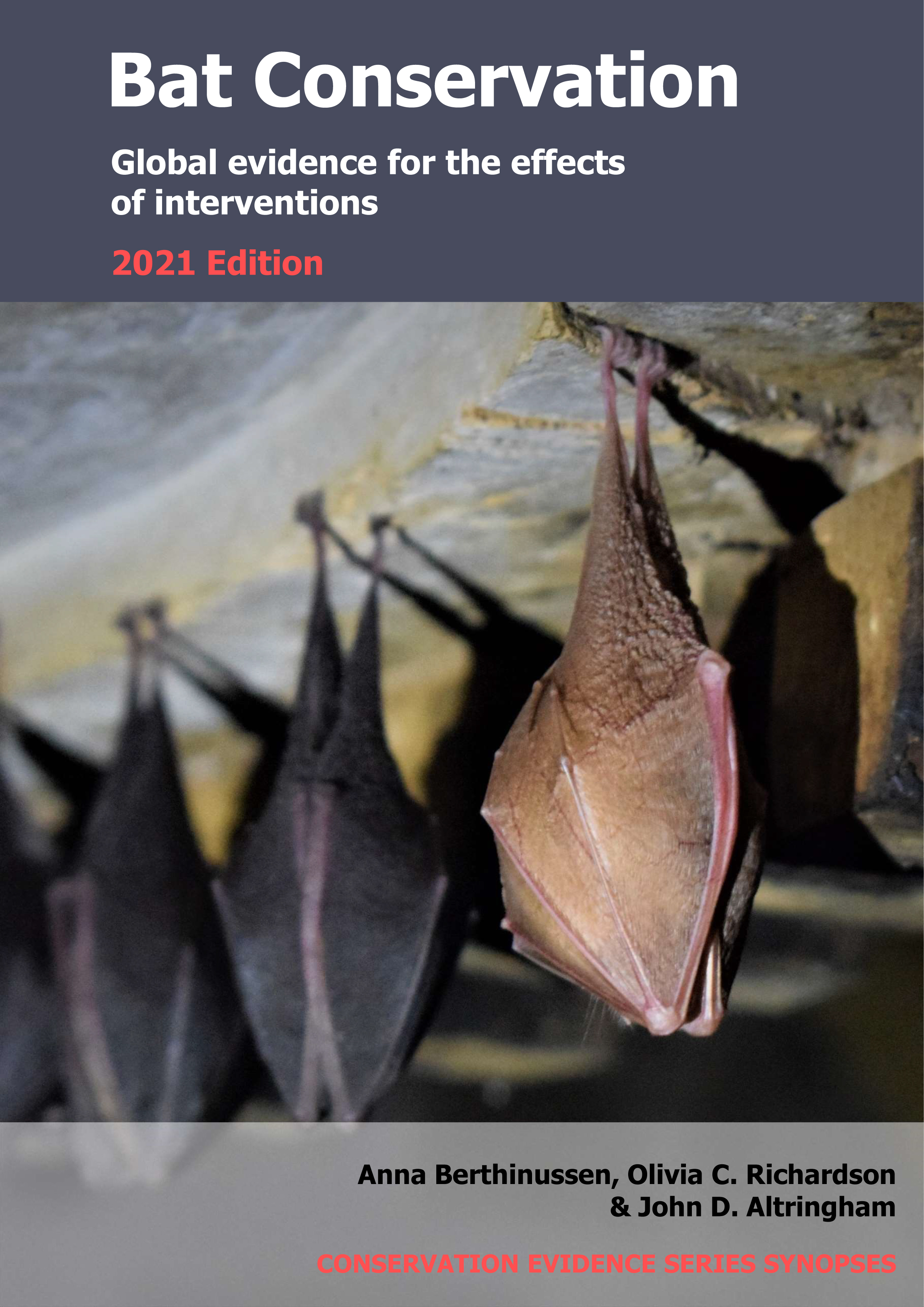Impose restrictions on cave visits
-
Overall effectiveness category Likely to be beneficial
-
Number of studies: 4
View assessment score
Hide assessment score
How is the evidence assessed?
-
Effectiveness
67% -
Certainty
50% -
Harms
0%
Study locations
Supporting evidence from individual studies
A study in 1997–1998 in one cave in Arizona, USA (Mann et al 2002) found that reducing the number of people within cave tour groups did not have a significant effect on the number of take-offs, landings or overall activity of a roosting cave myotis Myotis velifer colony. A similar number of take-offs and landings were observed, and a similar proportion of the colony was active when tour groups had 1–3 people or 6–8 people (data reported as statistical model results). A colony of 1,000 cave myotis bats roosted in a large cluster within one room of the cave. Experimental tours were carried out through the room with five replicates of each of 24 treatment combinations. Treatments included size of tour group (0, 1–3 or 6–8 people), light intensity and colour (no light, low intensity white light, full red light, full white light), and voice intensity (no people talking, all members of group talking). A total of 120 experimental cave tours were carried out between April and September in 1997 and 1998. Bat behaviour was observed with a night-vision video camera and infrared lights.
Study and other actions testedA before-and-after study in 1983–2009 at one cave in the Rocky Mountains, Canada (Olson et al 2011) found that enforcing restrictions on cave visitors resulted in more bats hibernating within the cave. An average of approximately 450 bats/year hibernated in the cave before restrictions were enforced, and 650 bats/year after. The cave (length 2791 m, depth 220 m) was highly popular with recreational visitors. In 1997, seasonal access restrictions were imposed. In 1998, the area was established as a National Park and signs were erected to inform the public about access restrictions. Active enforcement to restrict recreational visitors in winter months began in 2000. An annual census of visual counts of hibernating bats was carried out in 11 chambers within the cave from 1983 to 2000, followed by a census every other year until 2009.
Study and other actions testedA study in 2004–2005 in one cave in northern Madagascar (Cardiff et al 2012) found that increasing visitor approach distances, along with avoiding direct illumination of bats, reduced the alertness and number of take-offs of Madagascan rousettes Rousettus madagascariensis during tours. When visitors approached to 12–14 m and did not directly illuminate the bats, the proportion of alert bats (with eyes open; reported as eye-shine ratios) and the average number of take-offs was similar during tours (3 take-offs) compared to before (2 take-offs) and after (4 take-offs). Whereas when visitors approached to 5–6 m and shone headlamps on the bats, there were more alert bats and take-offs during tours (37 take-offs) than before or after (both 1 take-off). Approaching to 12–14 m with direct illumination and approaching to 5–6 m without direct illumination also resulted in more alert bats and/or take-offs during tours than before or after (see original paper for data). A colony of 2,500 Madagascan rousettes roosted in the cave, frequently visited by tourists. Experimental tours were carried out with three replicates of each of four treatment combinations. Groups of three visitors approached bats roosting on the cave wall to 5–6 m or 12–14 m and either directly illuminated bats for one minute (with three LED headlamps, total 4–8 lux) or shone headlamps downwards only. Bat behaviour was recorded with an infrared video camera for 15 minutes before, during and after each of the 12 experimental tours in June–July 2004 and July 2005.
Study and other actions testedA before-and-after study in 2002–2008 at a cave system in forested mountains of Turkey (Paksuz & Özkan 2012) found that restrictions put in place to reduce human disturbance resulted in an increase in the number of 15 bat species using two caves in the system. Maximum counts of bats in the two caves were higher after the cave system was opened to tourism and restrictions were put in place (before: 42,800 hibernating and 7,900 breeding bats; after: 54,600 hibernating and 11,000 breeding bats). A third cave in the system, which remained closed to tourism, had similar numbers of bats throughout the study period. Before opening to tourism, recreational users had made frequent uncontrolled visits to the caves. After opening for tourism in 2003, gates were installed on two entrances, daily and seasonal timing of visits were controlled by security guards, tourists were guided along set routes away from colonies with time limits for visits, information signs were erected, and lights were switched off outside of visiting times. The study does not distinguish between the effects of different restrictions carried out at the same time Bat colonies were counted every 40 days with 15 surveys before (2002–2004) and 38 surveys after opening to tourism (2004–2008). Update 2018: The findings of this study have been challenged, see Furman et al. 2012.
Furman A., Çoraman E. & Bilgin R. (2012) Bats and tourism: a response to Paksuz & Özkan. Oryx, 46, 330–330.
Study and other actions tested
Where has this evidence come from?
List of journals searched by synopsis
All the journals searched for all synopses
This Action forms part of the Action Synopsis:
Bat Conservation
Bat Conservation - Published 2021
Update 2020





)_2023.JPG)














